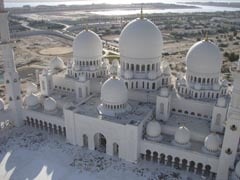Readers projects : Sivec in the sun
The new Grand Mosque in Abu Dhabi is an extraordinarily impressive stone-clad building visited last year by the Queen during her tour of the United Arab Emirates. One of those her who met her at the mosque was Kevin Dean, the artist from Southsea, Portsmouth, who designed the 18,000m2 marble mosaic courtyard floor as well as floors and walls inside the mosque using 37 different kinds of marble cut by Italian specialists Fantini Mosaici, much of it on a CNC waterjet (as we reported at the time – see the November 2010 issue). But the mosaics are only part of the stunning stonework on what is the fourth largest mosque in the world. The US $800million structure is clad in 145,000m2 of White Sivec, a fine-grained white dolomitic marble from Macedonia. It was fixed by Haz, the international company whose UK base is in Hatfield, Hertfordshire, using a stainless steel fixing system made by their sister company, Haz Metal. Here we look at the work involved in the project.
The Grand Mosque is a cultural and Islamic monument in Abu Dhabi in the United Arab Emirates that was commissioned by the late King of Abu Dhabi, Sheikh Zayed Bin Sultan Al Nahyan. It is oustanding.
The Italian construction company Impregilio built the shell. Then the British engineering firm Halcrow took over the design and management of the work while Belgium’s Six Construct – who have since won the US $490million contract to build what will become Abu Dhabi’s tallest tower for the Abu Dhabi National Oil Company, again with Halcrow as consultants – were responsible for the construction work itself. The overall budget for the mosque was US $800million.
Sheikh Zayed Bin Sultan Al Nahyan did not live long enough to see the mosque completed. He died In November 2004 but the work continued, leaving a religious and cultural monument for future generations of worshippers and tourists to marvel at. His tombe is next to the Grand Mosque and has been constructed to reflect the design of the mosque.
Every statistic about this building is impressive. It covers an area of 22,000m2 and can accommodate 40,000 worshippers. It has four minarets, each 100m high. There are 82 domes, the main one 32m wide and 70m heigh. The external façade is clad with 145,000m2 White Sivec marble from Macedonia, chosen for the consistency of its colour. More than 2,000 individual cutting templates were required to produce the cut-to-size stone. There is engraving and inlaying, in some cases with gems, that has been performed on CNC workcentres.
The 18,000m2 courtyard with its marble mosaics designed by British artist Kevin Dean was produced from 37 kinds of stone by Italian specialists Fantini Mosaici and took 400 people a year to lay.
It is surrounded with stone arcades in a rectangular pattern and on top of the arcade are merlons in the same stone. The 100m high minarets are clad in diamond shaped stone panels with borders lining spaces forming motifes of Islamic origin. On each minaret are three balconies, at the 60th, 80th and 90th metre.
There are 82 domes clad in the White Sivec marble. Each tier of stone in each of the different size domes had to be cut to different dimensions to accommodate the horizontal and vertical curves of the domes.
Haz Marble United Arab Emirates were the subcontractor for the stonework on the project. The scope of their work included the preparation of workshop drawings for cutting the stone, supply and design of the fixing systems that were manufactured by their sister company, Haz Metal in Turkey, and installation of the external White Sivec cladding. Haz were also responsible for the supply and installation of the 96 stone columns in the Mosque.
Haz Marble’s detailing for the design of each individual stone and the fixings for them played a key role in realizing the high standards set by Halcrow. The British consultants maintained a strict control over the design and supply process for both the fixings and the stone, including a random testing regime for the stone as it arrived on site to ensure it was consistently up to standard.
Haz Metal, based in Iskenderun, in the southern part of Turkey, manufactured 1,500tons of Grade 316 stainless steel fixings. They say the greatest challenge was to design and build a frame that had to accommodate the intricate design of the finish of the building on a concrete shell substrate built with a flush surface. The frame had to support the architectural features of the façade.
Steel channels were supported on brackets to form the secondary structure on which the stone panels were fixed using anchors. The balconies on the minarets are cantilevered using sub-channel systems. The domes are clad using a metal grid made up of vertical and horizontal channels in which horizontal adjustable fixings enabled the stone to be quickly and easily installed.
Haz Metal provide a design and production service for stainless steel fixing systems for natural stone installation and a variety of other products used in construction. They supply clients all over the world with easy to use, secure and economic fixing systems produced in accordance with international standards.
Haz Metal have 200 employees, both in Turkey and in their overseas branches. The fixing company is part of the Haz operation in Hatfield and their systems are part of the services and products offered in the UK by the group.
Haz Metal started producing fixing systems in 1993. Today, the company has the technical know how and technology to produce all types of natural stone fixing systems used for ventilated stone facades. Production of a variety of fixing systems such as channels, cast-in channels, masonry support anchors and expansion bolts is also available. Standard and customized production is made to meet the special application requirements.

